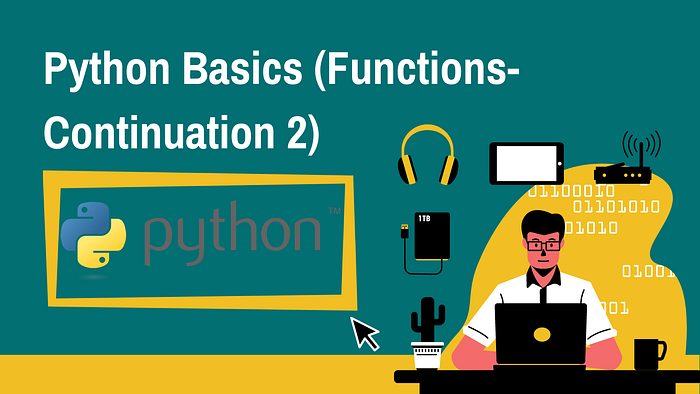Python Basics (Functions- Continuation 2)

Lambda Function:
A “lambda function” in Python is a concise way to create anonymous functions. These functions are also known as “inline” or “lambda” functions because they are defined without a name. Lambda functions are often used for short-term, specific operations where a full function definition seems unnecessary.
Here’s the basic syntax of a lambda function:
lambda arguments: expression- `lambda`: The keyword that signifies the creation of a lambda function.
- `arguments`: The input parameters the lambda function takes.
- `expression`: The single expression or operation that the lambda function performs.
Here’s an example of a simple lambda function that adds two numbers:
add = lambda x, y: x + y
result = add(3, 5)
print(result) # Output: 8In this example, `lambda x, y: x + y` defines a lambda function that takes two arguments (`x` and `y`) and returns their sum. The function is assigned to the variable `add`, and then it’s called with `add(3, 5)` to get the result.
Lambda functions are often used in situations where you need a quick function for a short operation, like sorting or filtering. For instance:
numbers = [1, 4, 2, 7, 5]
sorted_numbers = sorted(numbers, key=lambda x: x**2)
print(sorted_numbers) # Output: [1, 2, 4, 5, 7]Here, `lambda x: x**2` is used as the key function for sorting the numbers based on their squares.
While lambda functions are useful for certain scenarios, keep in mind that they are limited compared to full function definitions, particularly in terms of complexity and readability. Use them judiciously, and opt for regular functions when you need more extensive or reusable code.
Recursive Function:
In Python, a recursive function is one that makes calls to itself while it’s running. Recursive functions come in handy when attempting to solve problems that can be divided into more manageable, related subproblems. Recursion’s main concept is to break a problem down into smaller subproblems and solve each one separately before combining the answers.
Here’s the general structure of a recursive function:
def recursive_function(parameters):
# Base case(s): The condition under which the function stops calling itself.
if base_case_condition:
return base_case_result
# Recursive case(s): The function calls itself with modified arguments.
else:
recursive_result = recursive_function(modified_parameters)
return combine_results(recursive_result, additional_data)Key components of a recursive function:
Base Case: The circumstance in which the function ceases to call itself is known as the base case. It makes sure that the cycle doesn’t go on forever. The function doesn’t make any more recursive calls after the base case is satisfied and returns a result.
Recursive Case: When the function calls itself with altered arguments, this is known as the recursive case. This enables the function to divide the issue into more manageable versions of the same issue.
Termination: When the base case is reached, the recursion ends, and the function begins to return results via the series of recursive calls.
This is a typical illustration of a recursive function: finding a number’s factorial.
def factorial(n):
# Base case
if n == 0 or n == 1:
return 1
# Recursive case
else:
return n * factorial(n-1)
# Example usage
result = factorial(5)
print(result) # Output: 120The factorial of a number is computed using the recursive function factorial in this example. In the recursive case, the function calls itself with a smaller value (n-1). In the base case, n is either 0 or 1.
In order to prevent infinite recursion when working with recursive functions, it’s crucial to make sure the base case is clearly defined and that the function converges towards the base case with each recursive call.
Functions vs Methods
Functions:
Independence: Without an object association, a function is a stand-alone block of code. It is possible to define and utilize functions independently of a particular object or class.
Direct Invocation: Parameters are passed inside parenthesis when calling a function directly using its name.
Example:
def square(x):
return x ** 2
result = square(5)Data Handling: Functions are often used to pass or return data between different parts of a program.
Methods:
Object Association:
- A method is a function that is associated with a specific object or class.
- Methods are defined within a class and operate on the data of instances of that class.
Invocation with Objects:
- Methods are called using the dot notation on an object, indicating that they are bound to that specific object.
Example:
my_list = [1, 2, 3]
my_list.append(4)Data Operations in a Class:
- Methods are designed to operate on the data within a class. They can modify the state of the object they belong to.
